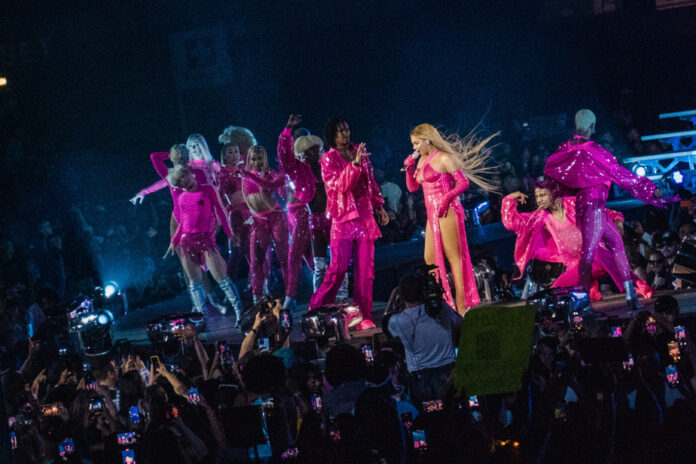After Taylor Swift, Beyoncé will allow those who missed her on stage to see her on the big screen. Filmed during its last tour, Renaissance will be released in December. Why did these two stars embark on such an operation? And do these near-simultaneous releases mark a turning point for concert films? Let’s try to see it more clearly…
Somehow. If you couldn’t afford a trip to Toronto, the only Canadian city, along with Vancouver, where the singer stopped as part of her latest tour, here’s your chance. Beyoncé unveiled the trailer for Renaissance on Tuesday, the recording of her tour of the same name, which ended in early October in Missouri. Expected on December 1, the film promises to reveal behind the scenes of a world tour that grossed more than $460 million for the American singer.
She follows in the footsteps of Taylor Swift, whose film documenting her successful tour will be released next Friday. The distributor of the feature film Eras Tour, AMC Theaters, announced that ticket pre-sales have already generated $100 million in revenue. As for Beyoncé’s documentary, it reportedly raked in $6 million to $7 million after the first day of presales, revenues comparable to those of Avatar: The Way of Water and Guardians of the Galaxy: Vol. 3 at the same stage.
Not only. Taylor Swift’s tour, for example, could generate revenues of 1.9 billion, according to some estimates, so a few hundred million more or less… The concert film is above all a matter of image, estimates Danick Trottier , professor of musicology at the University of Quebec in Montreal. “It helps control the discourse around the tour,” he notes. The artist is presented as a superhuman being in the efforts he makes, evening after evening, to entertain tens of thousands of people for hours. “We highlight the artist as someone exceptional,” underlines Mr. Trottier.
The concert film also allows you to leave a mark. Unlike an album, a tour has an end. By documenting her tour, Beyoncé gives it a second life. “It allows you to capture attention, to create an event. Is this also a way for her to draw the spotlight on herself, when there is a lot of spotlight on Taylor Swift currently? », asks Danick Trottier.
It’s not like the real experience, we agree. But the concert film also has its qualities, notably the fact of taking the audience behind the scenes. “We always want to know more! The relationship between the artist and the fan is nourished by this curiosity. How does the artist motivate himself before a concert? What is his routine? », underlines Danick Trottier.
Then there is the question of accessibility. “Today, seeing these stars is extremely expensive,” admits the professor. The cost of a ticket to the floor for the Eras tour can run into the thousands of dollars due to dynamic pricing. For many fans, the film is the closest they will ever get to seeing their idol perform, for a fraction of the price. “It’s clear that it compensates for a frustration that some have of not being able to see their favorite star on stage,” maintains the professor.
“It’s a growing niche and I think we’re moving to another stage with Taylor Swift and Beyoncé,” replies Éric Bouchard, co-president of the Association of Quebec Cinema Owners.
It is not new that cinemas present concerts on their screens. However, it is true that the genre had run out of steam somewhat in recent decades (if we ignore live recordings of operas from the Met, for example).
Trottier said concert films were particularly popular in the 1960s and 1970s, especially among rock artists. “One of the first notable cases was What’s Happening! The Beatles in the U.S.A., released in 1964, which was about the group’s arrival in the United States,” he explains. Then there was Gimme Shelter with the Rolling Stones (1970), The Last Waltz with The Band, Bob Dylan, Neil Young and Joni Mitchell (1976), without forgetting Stop Making Sense with Talking Heads (1984), to name a few. those…
“There, I feel that there is a return,” observes the professor. “There may be a link with the arrival of digital platforms like Netflix. We feed ourselves a lot of musical documentaries. There is plenty of supply,” he continues.
And now, these two films with the biggest names in pop will be released… “We tend to see cinema and music as two distinct arts, but there are communicating vessels. Artists already cultivate their image through their concerts and their records, so why not in the cinema? », he concludes.















